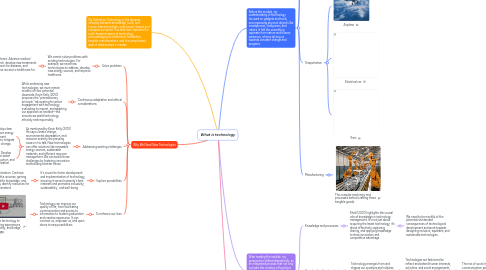
1. My Definition: Technology is the dynamic interplay between knowledge, tools, and human interaction that continuously shapes and reshapes our world. This definition captures the multi-faceted nature of technology, acknowledging its intellectual foundation, tangible manifestations, and the complicated web of relationships it creates.
2. Before the module, my understanding of technology focused on gadgets and tools, encompassing physical objects like smartphones, computers, and robots. It felt like something separate from nature and human existence, a force driving us towards constant change and progress.
2.1. Ai robots
2.2. Devices
2.2.1. Cell Phone
2.2.2. Computers and laptops
2.2.3. Tablet
2.3. Trasportation
2.3.1. Airplane
2.3.2. Electrical car
2.3.3. Train
2.4. Manufacturing
2.4.1. The complex machinery and processes behind crafting these tangible goods
3. After reading the module, my perspective shifted dramatically. as an integrated process that not only includes the creation of tools but also encompasses the methods, knowledge, and interactions that define our modern world. The dynamic force drives change and reflects our values and choices.
3.1. Knowledge and processes
3.1.1. Khalil (2001) highlights the crucial role of knowledge in technology management. It's not just about acquiring the latest technology; it's about effectively capturing, sharing, and applying knowledge to drive innovation and competitive advantage
3.1.1.1. We need to be mindful of the potential unintended consequences of technological development and work towards designing inclusive, equitable, and sustainable technologies.
3.2. Social and cultural context:
3.2.1. Technology emerges from and shapes our societies and cultures, reflecting values, beliefs, and power dynamics (Schatzberg, 2006).
3.2.1.1. Technologies are fashioned to reflect and extend human interests, activities, and social arrangements, which are, in turn, conditioned, structured, and transformed by technological systems ( Kaplan, 2003).
3.2.1.1.1. The rise of social media has shaped communication patterns and social norms, while automation and AI are changing the nature of work and leisure.
3.3. Dynamic and evolving
3.3.1. This includes everything from factories and robots to the intricate networks of people, regulations, and resources involved in production.
3.3.1.1. .
3.3.1.1.1. As mentioned by Kevin Kelly (2010) In his talk, he says technology isn't separate from the natural world. Like life, it's a dynamic process, constantly adapting and evolving. It's an extension of our biological drive to create order and complexity.
4. Why We Need New Technologies
4.1. Solve problems
4.1.1. We cannot solve problems with existing technologies. For example, we need new technologies to address, develop new energy sources, and improve healthcare.
4.1.1.1. Healthcare: Advance medical research, develop new treatments and cures for diseases, and improve access to healthcare for all.
4.2. Continuous adaptation and ethical considerations
4.2.1. While embracing new technologies, we must remain mindful of their potential downside. Kevin Kelly (2010) proposes the "precautionary principle," advocating for active engagement with technology, evaluating its impact, and adapting our approach as needed—this ensures we wield technology ethically and responsibly.
4.3. Addressing existing challenges
4.3.1. As mentioned by Kevin Kelly (2010) He says climate change, environmental degradation, and resource scarcity are pressing issues in his talk. New technologies can offer solutions like renewable energy sources, sustainable materials, and efficient resource management. We can tackle these challenges by fostering innovation and building a better future.
4.3.1.1. Climate change: Develop clean energy sources, improve energy efficiency, and implement sustainable practices to mitigate the effects of climate change.
4.3.1.2. Resource management: Develop efficient technologies for water conservation, waste reduction, and sustainable resource utilization.
4.4. Explore possibilities
4.4.1. It's crucial to foster development and implementation of technology, ensuring it serves humanity's best interests and promotes inclusivity, sustainability, and well-being
4.4.1.1. Space exploration: Continue exploring the universe, gaining new scientific knowledge, and potentially identify resources for future generations
4.5. To enhance our lives
4.5.1. Technology can improve our quality of life, from facilitating communication and access to information to fostering education and creative expression. It can connect us, empower us, and open doors to new possibilities.
4.5.1.1. Education: Utilize technology to personalize learning experiences, improve accessibility, and bridge the educational gap.
4.5.1.1.1. technology's journey in education has been long and transformative. Understanding its history and recognizing its potential and limitations allow us to utilize it effectively shaping a future where technology empowers learning, cultivates well-rounded individuals, and bridges the gap to a brighter future.
